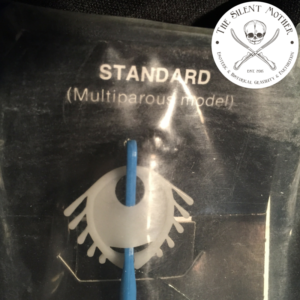
I have a Secret Santa who sent me a rather large box of interesting objects. My Secret Santa included a new-in-the-package Dalkon Shield IUD. As a collector, I was giddy when I saw it. This particular IUD has caused long term fear and loathing of all IUD’s. Yet, most women don’t know the story behind it. They know that IUD’s caused “problems” and that other methods of birth control were “better”. Even now, I hear women say they’d never get an IUD. That is a shame because IUD’s today are the most effective birth control on the market.
Let’s dig in to the story behind the Dalkon Shield and this pervasive fear of IUD’s.
In 1971, the A.H. Robbins company brought the Dalkon Shield to market, billed as a safer alternative to The Pill. The birth control pill, still being relatively new, had some kinks yet to be worked out. Many women were unhappy with it’s side effects and were searching for something that was safe and effective. Given the hole in the market, it was a prime business opportunity for A.H. Robbins and this new style of IUD.
IUDs have been around for a over a thousand years, in various shapes and forms. The Dalkon Shield, however, had something new going for it – a mass marketing campaign. Well, that and a different physical structure and an entirely different kind of string… but we’ll get to that in a minute.
This marketing campaign was so successful that approximately 2.8 million women eventually used the Dalkon Shield. They were, however, unaware of the lack of proper testing on this device and its safety.
Although A.H. Robbins tested the Dalkon Shield for efficacy, they did not test it for safety. At the time, that was not required before putting it out to market. The company also padded it’s efficacy rate to show a 2-3% failure rate, as opposed to the 10% failure rate it actually had.

There was a rather large problem with the Dalkon Shield. The string which attaches to the plastic IUD was made of a multi-filament string instead of a mono-filament string. Why is this an issue? Well the multi-filament string allows bacteria to creep up into the uterus whereas a mono-filament string does not. Bacteria, as we know, causes infection. Infection leads to sepsis. Sepsis leads to hospitalization, massive doses of antibiotics, the potential for surgery and so on. The biggest complaint being pelvic inflammatory disease, which beyond it’s discomfort, can lead to infertility.
All of this lead to five deaths, multiple spontaneous abortions and over 300,000 lawsuits against A.H. Robbins. The company folded under the pressure.

So after all that, there is an upside. Women stood up for themselves and for better medical testing. The success came in 1976 when the FDA added the Medical Device Amendments to their policies. Change is often slow. These women, of my mother’s generation, took to the streets, the media and the courts to protest and affect change. It makes me wonder what we could do now, should we rally.
In the meantime, I’ll hang on to this piece in my collection to remind me of how far we’ve come, and how far we still have to go to support women’s rights with regards to access to safe birth control, safe abortion and bodily autonomy.
Please support The Silent Mother by becoming a patron through Patreon.
Your generous donation allows me to keep writing.

You are naive to think that IUDs are now safe. I encourage you to seek out the support groups for women who are suffering from having chosen current IUDS available on the market. Your collection of damaging IUDs will be growing by leaps and bounds very soon. If you are considering getting an IUD or have one already I hope you are DONE having kids or never ever wanted them in the first place. IUDs are very damaging. I know from experience. I struggled to have my third child for years. I almost squandered my fertility using a mirena IUD. If I had become infertile I would have been a repeat customer for big pharma…they sold me the IUD, and they would again sell me fertility drugs. Its a vicious cycle.
It sounds like you’ve had a very long road to conception, post IUD (Mirena) removal. For, that I am sorry. My heart goes out to you, as it does for all women struggling with infertility issues. Secondary infertility, as in your case is extremely frustrating, given that you have been able to concieve and carry successfully in the past.
From what you wrote, however, I do not see the link between your IUD and your infertility. Nor does the evidence support your assertion. The only long term effects post removal are if you had PID prior to insertion. Otherwise, all side effects end after removal. PID is a sexually transmitted disease.
There are a number of contraindications to usage. I do hope you had full informed consent and you read the package insert thoroughly before you had it inserted.
So, the likelyhood of your infertility issues being related to the Mirena are very, very low, if at all. Your anger and frustration are misplaced and misdirected at big pharma. It would appear that your lack of explanation from the medical community has caused you anguish. For that, you will need to work through on your own. Again, I am sorry for your suffering.
See:
https://www.plannedparenthood.org/learn/birth-control/iud
http://www.webmd.com/sex/birth-control/intrauterine-device-iud-for-birth-control
https://www.mirena-us.com/safety/
I was one of those Dalkon Shield women. Lifelong autoimmune conditions have followed. Wish there could be a study of women now nearly 50 years out to see long term effects. My dearest friend also a Dalkon Shield survivor died 10 years ago due to Scleroderma. We need data. ALSO!!’ I am an advocate now against most iud’s. My daughter has suffered tremendously after having the Mirena for just 4 months. 3 years post removal & she is too sick to work.
Oh wow, I’m glad you came through and survived your Dalkon Shield experience. I would be curious too, to know of any long term side effects of the device. We do need data, for sure.
Complications from any medical treatment, device, procedure or medication can and do happen. I’d be cautious, however, of drawing correlations, without direct evidence, of IUDs in general or the Dalkon Shield, to autoimmune disorders or long term complications. This is akin to the myth that vaccines cause autism, which they do not. Correlation is not causation and correlation without evidence is belief not fact. I’d be careful not to spread fear with as yet unfounded beliefs.